Sunken Treasure at Hell Gate, New York City
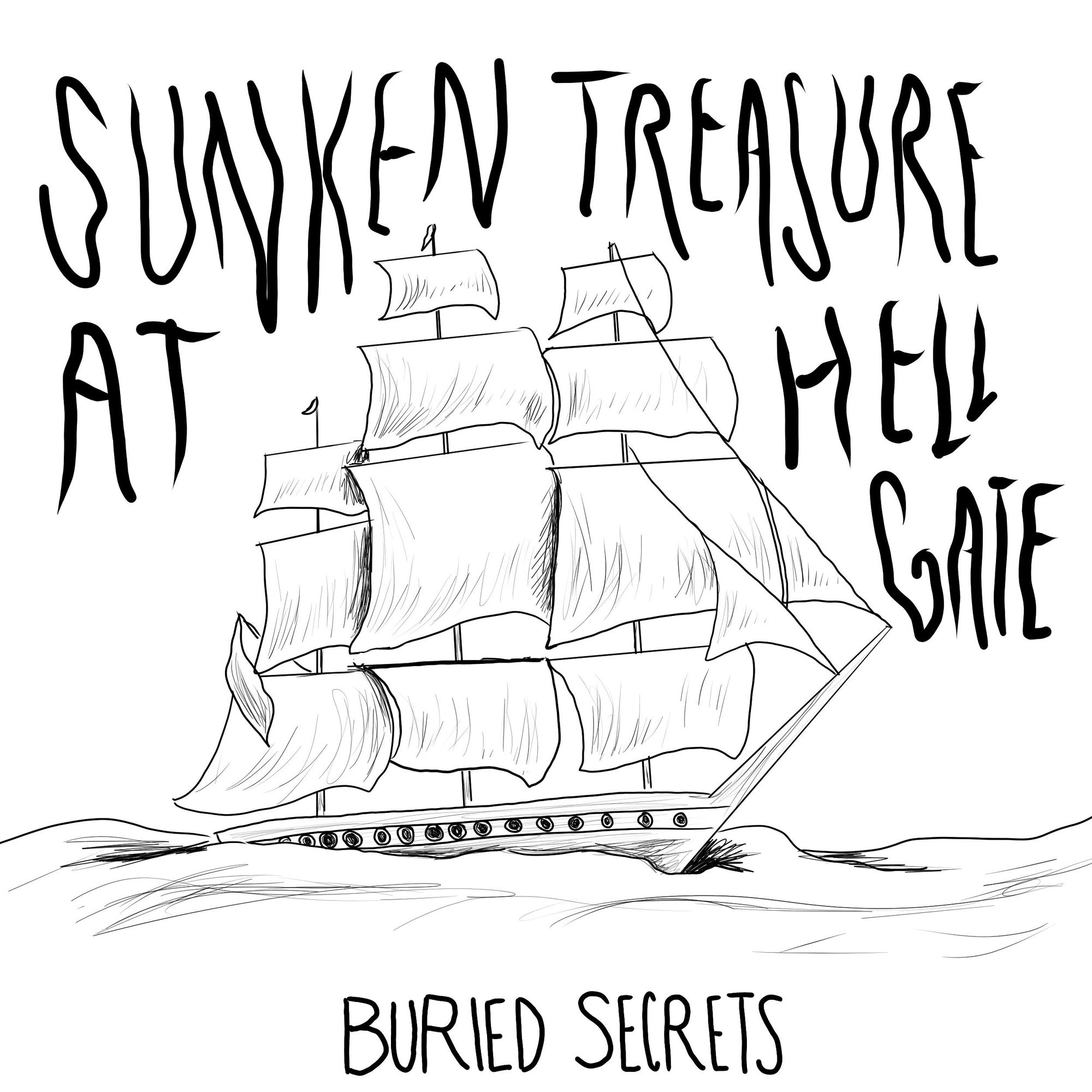
Sunken Treasure at Hell Gate, New York City: Legend has it that beneath the East River lies millions of dollars in gold.
In 1780, during the Revolutionary War, a British frigate called the HMS Hussar struck a reef and sank to the bottom of the East River. Many people believe that the ship carried an enormous amount of gold as payroll for British soldiers.
Despite its location in the most dangerous waters in the area, treasure hunters have searched for the Hussar in vain for years. One submarine inventor lost his entire fortune in the search for the treasure, while other salvagers have sunk millions into the search. If the treasure is there, it seems that it doesn’t want to be found . . .
Highlights include:
• A loaded cannon found in Central Park in 2013
• Shipworms, aka the “Termites of the Sea”
• Hidden treasure maps found at the New York Public Library
• The inventor of the modern submarine
• The largest explosion before the atomic bomb
Pictures of the Hell Gate
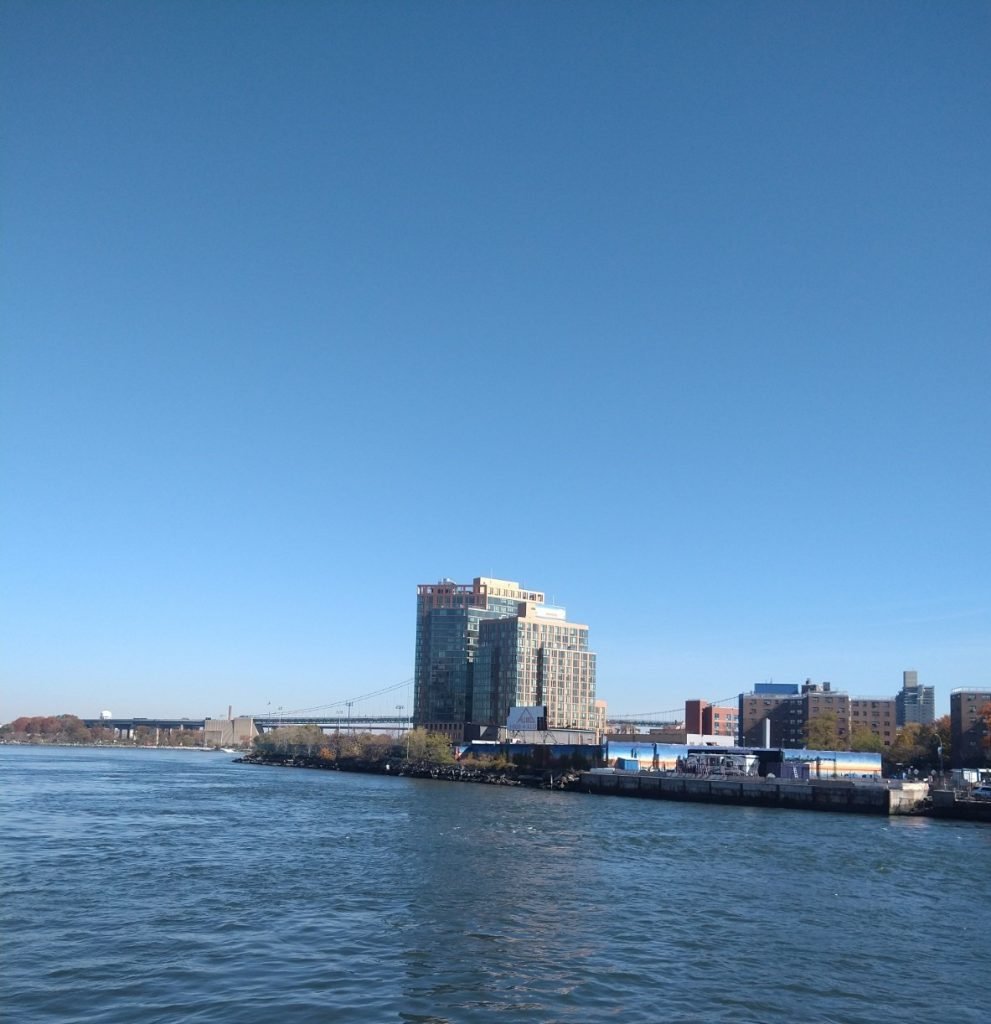
Hallet’s Point and the Hell Gate
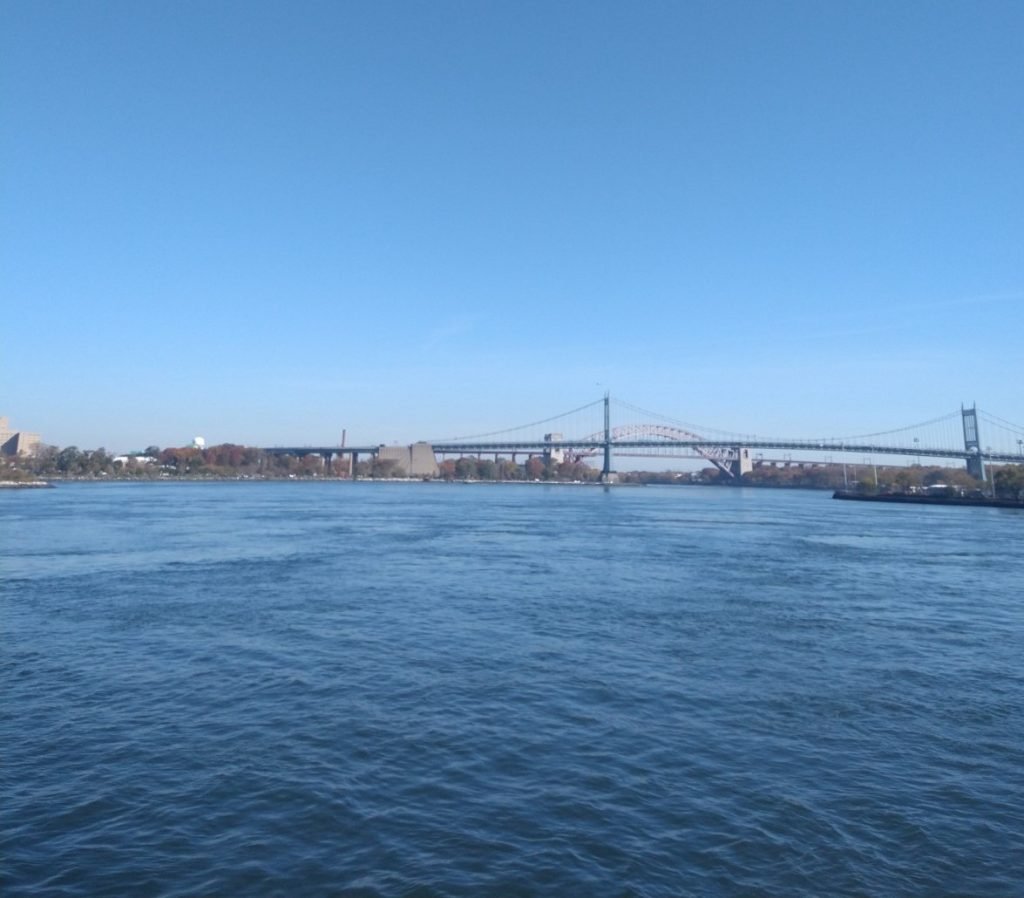
The Hell Gate, with the RFK and Hell Gate Bridge in the distance
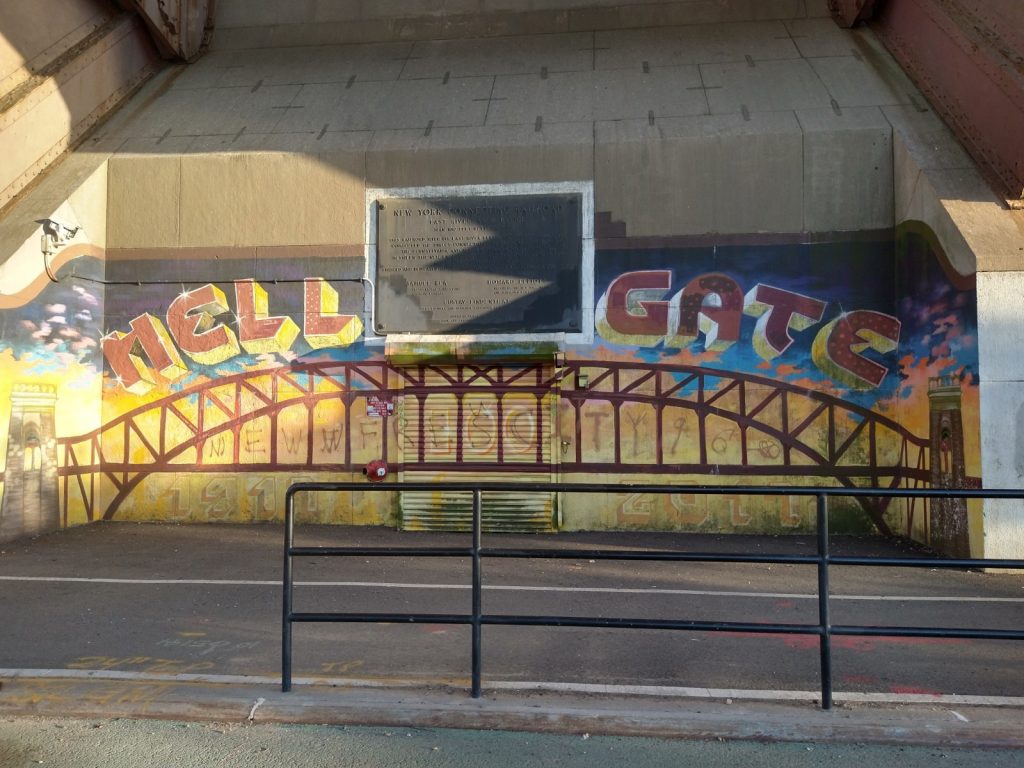
Hell Gate mural beneath the Hell Gate bridge in Astoria Park
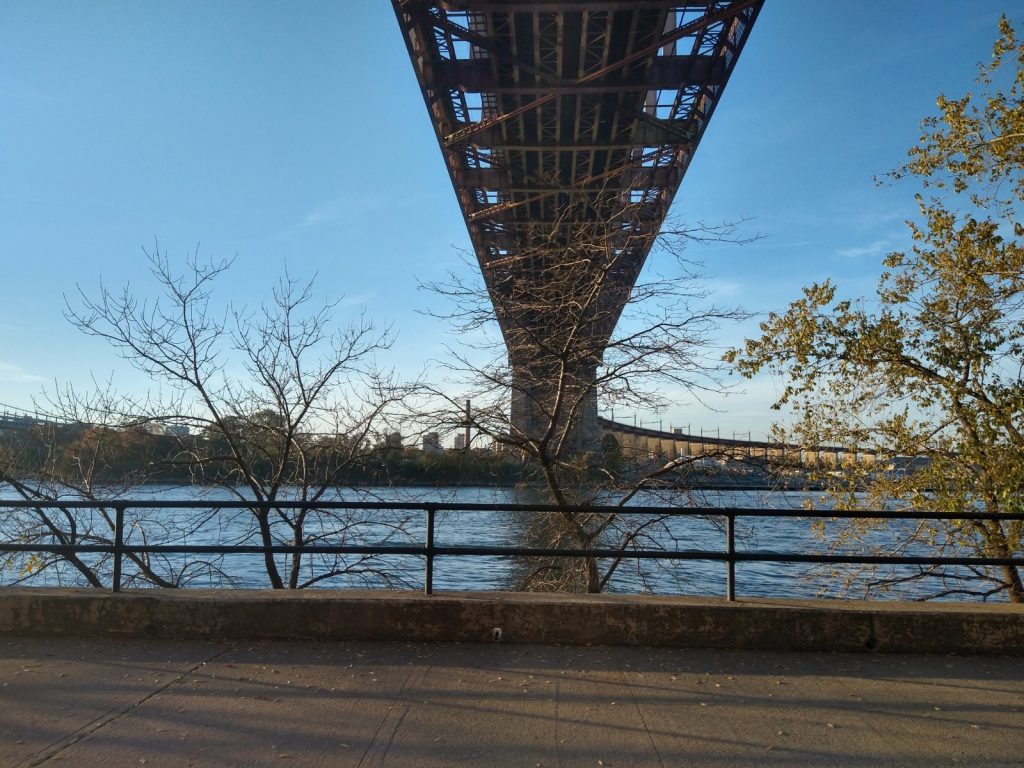
The Hell Gate and Hell Gate Bridge seen from Astoria Park
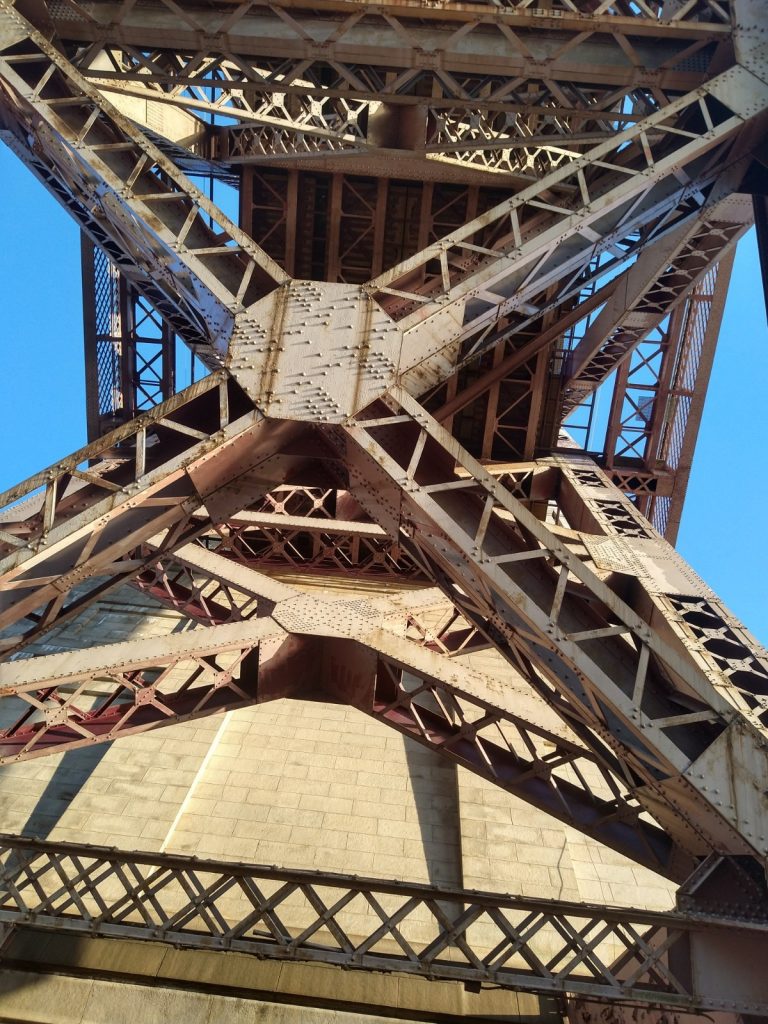
The bottom of the Hell Gate bridge
Episode Script for Sunken Treasure at Hell Gate, New York City
DISCLAIMER: I’m providing this version of the script for accessibility purposes. It hasn’t been proofread, so please excuse typos. There are also some things that may differ between the final episode and this draft script. Please treat the episode audio as the final product.
“There must be some mania at work to explain those who plunge into the violent murk of Hell Gate, looking for a ship that may be nothing more than a splintering of worm-eaten wood.” -from a 2002 article in the New York Times
“But for more than two centuries, an ordinary British frigate pressed into service during the Revolutionary War has been the object of countless searches in and around the East River. The H.M.S. Hussar might have been forgotten along with other shipwrecks lying at the bottom of New York’s waters, if not for one thing: an oft-repeated story that it might have gone down with a fortune in gold coins.” -from a New York Times article, September 4, 2013
“The Hussar sits out there as a ship of dreams. It has value because it’s part of the story, it’s part of the history of New York.”
-James Sinclair, a marine archaeologist who was part of an expedition in 2000 to the Titanic shipwreck, quoted in a 2013 New York Times article
“Simon Lake, the submarine inventor, who announced that he soon is going to try to salvage the gold from the supposedly gold-laden British frigate Hussar, which sank in Hell Gate in 1780, is far from the first to attempt it.” -The New Yorker, October 13, 1934 P. 22
- There are literally hundreds of places in America named after either hell, or the devil. Often, the locations earn their name by some geological element that makes the area especially dangerous, or ominuos looking. It’s also common for places with the name hell to have stories of hauntings.
- New York City’s Hell Gate ticks both boxes. I’ve heard people compare it to the Bermuda Triangle, because it was once so dangerous that 1,000 ships ran aground there every year.
- Located in the East River, just north of Roosevelt Island, is a tidal strait called Hellgate.
- It’s at the confluence of three bodies of water: the Hudson River, coming down from Upstate New York; the Long Island Sound; and the East River.
- And to make matters worse, until the late 19th century, the waters were full of huge rocks that boats tended to wreck on. There were also lots of whirlpools.
- Even though the waterway is safer now, it still looks pretty intense, full of eddies and areas that, to me, look suspiciously like whirlpools. I actually ran along the Hell Gate this weekend, and took a ferry across the east river just south of the Hell Gate. It’s a beautiful view these days, but definitely still feels ominous, even on a sunny day like the one this weekend, when the park along the waterfront, Astoria Park, was packed with people having picnics and working out.
- The strait was originally called Hellegat in Dutch, which I’ve read means “Hell Channel,” though other sources have said it means “bright strait” or “clear opening,” though those are much less apropos monikers. The area’s also sometimes been called Hurl Gate, which supposedly comes from the Dutch for whirl and for “hole, gap, or mouth,” so basically whirlpool.
- So today, I want to look at the second-most famous ship to have sunk at the Hell Gate: a British Royal Navy Mermaid-Class frigate called the HMS Hussar. It had 3 masts, 28 guns, and was built in 1763.
- The ship was 114 feet long, 34 feet wide, weighed 619 tons, and had a crew of 100.
- So here’s the story, and I’m gonna try to get the Revolutionary War history parts correct, but I’m a little weak when it comes to war history, so forgive me if I get anything wrong:
- So during the Revolutionary War, by 1780, the British weren’t doing so hot in New York. The French had joined forces with Washington’s troops, who were just north of the city.
- Also, at the time the British army owed a bunch of back pay to their soldiers.
- It was decided that the Hussar would bring the 960,000 British pounds worth of gold (which I think is like a billion and a half dollars in today’s money?) That number’s been disputed, but that’s partially because at the time, the British had good reason to downplay the amount of gold that was on board,
- There were also about 70-80 American prisoners aboard the ship, below deck.
- The captain decided to go through the Hell Gate, which the pilot had said was a bad idea.
- Legend has it that the Hussar had used an enslaved man named Swan as a pilot to navigate the Hell Gate. Swan’s widow claimed that she frequently heard him say that “there was a large quantity of money on board the ship when she sunk.”
- Right before they reached the Long Island Sound, the Hussar hit a reef called Pot Rock and started to sink. The Captain, Charles Pole, tried to run her aground, but instead she sank into 16 fathoms of water.
- While most of the British crew survived, all of the American prisoners went down with the ship.
- A 1856 expedition to the wreck found many bones, which, to quote the NYT: showed “evidently, that a part, if not all the American prisoners on board were manacled and chained”
- Of course, the British immediately denied that there’d been all that gold on board. But of course they did, since they wouldn’t have wanted the Americans to find it, and wouldn’t have wanted the Americans to know what a huge loss it was.
- But at any rate, at the inquest, the Captain said there was no gold on board when it sunk, and the first mate said they’d unloaded the gold before going upriver.
- For several days after the ship sunk, its masts stuck out of the water, though they were eventually swept away.
- Starting in the 1780s, people have tried in vain to find the ship. And, remember, the Hell Gate is a notoriously dangerous area, so that’d make treasure hunting that much harder.
- To quote Njscuba.net:
- “The Hussar is of historic interest only. It is sunk in Hell Gate, in the middle of New York City. The treacherous currents, polluted waters, and heavy traffic make it undiveable, except by professionals with specialized equipment.”
- Bob Sterner of Freeport, Long Island, who’s a shipwreck diver and former editor of Immersed Magazine, described Hell Gate this way:
- “Many divers don’t realize the conditions. Just in driving past Hell Gate, the waters appear angry. The currents are unpredictable as they swirl in one direction, then another, always moving and boiling like a hot pot. Slack tide lasts about 15 minutes.”
- Between the early 19th century and the 1980s, many people tried to find the ship. I wanted to talk about a few of them.
- Thomas Jefferson financed an expedition.
- There were at least three British expeditions to try to find the wreck, a fact that for many people reinforces the idea that there really was gold on it.
- An 1856 New-York Daily Times article said “In the spring of 1794 two brigs were dispatched from England to undertake the recovery of the lost treasure. They came fully equipped with men, a large diving-bell, and other equipments for sub-marine explorations.”
- In 1823, a man named Samuel Davis invented a machine to raise sunken ships and said he was going to raise the Hussar.
- In 1830, a group of English people using a diving bell tried to find it, and failed.
- There was one salvager in 1880 named George M. Thomas, who according to the NYT was “an itinerant street preacher turned patent medicine vendor”
- In 1900, divers looking for a sunken yacht found an iron anchor that said “HMS Hussar.” They sold the anchor for $20 in a junk shop.
- In the 1930s, a treasure hunter, mechanical engineer, and naval architect named Simon Lake searched for the Hussar.
- Simon Lake is an interesting character: he was a really important and influential submarine designer who built his first submarine in 1894 at the request of the navy.
- He had a bunch of underwater firsts: He took the first underwater pictures and movie and the first underwater ship-to-shore phone calls.
- Later in his life, he made submarines for non-military usage, including for the purpose of treasure hunting. However, despite his attempts, he didn’t find the Hussar.
- Or at least that’s what some sources say. Other places claim that he found the ship, but not the gold.
- There’s a great New Yorker article about it from October 13, 1934, that I wanted to read from:
- “Simon Lake, the submarine inventor, who announced that he soon is going to try to salvage the gold from the supposedly gold-laden British frigate Hussar, which sank in Hell Gate in 1780, is far from the first to attempt it. A giant vacuum cleaner is his description of the apparatus he is going to use. The first attempts to reach the Hussar were made while her masts were still visible above the water. In 1823 a man named Samuel Davis tried to raise the ship. In 1880 a Captain Thomas financed a salvage ship by selling stock in a company called Treasure T Trove, Inc. In the nineties a syndicate spent 20,000 dollars and got one of Hussar’s worm-eaten, oaken ribs, which was made into a cane and is now owned by a man in Brooklyn.”
- There’s also a 1935 NYT article which talked about how Lake worked on creating a “baby” submarine to find the Hussar. Apparently, he found three wrecks in the area, all of which were covered in 15 feet of silt.
- He then installed a glass window at the bottom of the submarine’s bow, and added a probing device that can be controlled from within the submarine.
- I searched “Simon Lake Hussar” in the historical NYT archives, ad the headlines really tell a story:
- They start in 1934 with LAKE’S SUBMARINE FAILS OF LAUNCHING: Mother Ship is Unable to Pull It Off Ways at Stratford — New Attempt Tuesday. TREASURE HUNT TO FOLLOW But Tests Come First — Coal Cargoes to Be Sought as Well as Sunken Gold.
- Then there’re articles about the hunt for the treasure in 1935, including one headlined, “HUNT PIECES OF EIGHT.: Lake’s Submarine Retrieves Pail and Clam Shell in East River.” The article talks about how Lake took journalists down in the submarine, as well as a Miss Mildred Stone. The article closes with “When yesterday’s excursion was over Miss Stone came to the surface with one pail, rusty, and one half of a clamshell in poor condition. Everybody else got grease stains on his clothes.”
- Then, in June 1936: LACK OF FUNDS HALTS LAKE’S TREASURE HUNT: His Submarine to Be Auctioned if He Fails to Get $394 to Pay Deckhand.
- Then, things look up by September 1936: LAKE THINKS HULK IS TREASURE SHIP: Inventor Believes He Has Found Wreck of Frigate Hussar in East River. CARRIED $1,800,000 GOLD Probing Reveals Hard Timbers in Indicated Position, and Treasury Is Notified.
- The article talks about how Lake called reporters into his office, and said, “If I were a betting man, I would lay 100 o 1 the Hussar has been found at last. For fifty years I have been spectulating on the likelihood of locating this ship and within six weeks I expect to step within her hold. Now, nobody can tell what gold there is. It’s not the gold so much as the satisfaction of solving a riddle, though some gold would do no harm.”
- Apparently, on September 4, Lake’s 70th birthday, he found the Hussar during a sounding expedition off the shore of the Bronx, around East 130th and 140th streets.
- He said that the ship was covered in 12 feet of silt, which they were going to pump off, so then the submarine and divers could go down and see the ship.
- He said that he believed he could raise the Hussar in time to be exhibited at the upcoming World’s Fair, which was scheduled for 1939 here in Queens, NY.
- But that was not to be. By November 1936, we get this headline: SIMON LAKE AGAIN SUED: Inventor Seeking $4,000,000 Gold In $1,800 Foreclosure Action.
- Basically he had some issues with back taxes and the mortgage on his house in Connecticut
- Then, in March 1937, there’s an article about his house being foreclosed on, and in November 1937, there’s an article about getting a delay n the foreclosure. That article says “Mr. Lake ran into financial difficulties about a year ago in attempts to salvage a $5,000,000 treasure in gold which some say sank in the East River at New York with the British frigate Hussar in 1780. The yield from the salvage venture has been meager.”
- In his autobiography, Lake said “No one now knows precisely where the old hulk rests, and my explorations early in 1937 were unsuccessful. I have not given up the idea, but other things are more pressing.”
- Then, in June 1945, the times printed Lake’s obituary. He was 78 when he died . The article gives a summary of what happened in the intervening years between his search for the Hussar and his death:
- He spent three years and a fortune in this venture while the world watched. All he recovered was a handful of modern coins. In 1937, his white-pillared colonial home in Milford, Conn., was sold under foreclosure and was made into a funeral parlor. The inventor moved up the street a few doors to a two-family house and continued to use his three-room workshop in a little factory building.
- There’s so much to unpack here: It feels almost like this treasure is cursed somehow–it drove this man to his ruin, and there’s something almost poetic about how, after losing his home to a search for a sunken treasure that a bunch of POWs died next to in a treacherous waterway, where so many people had died since then–after losing his house to that, it became a funeral parlor.
- The next treasure hunter I found good info about was from the 1980s:
- According to the New York Times, in 1985, a salvage expert named Barry L. Clifford claimed he’d found the ship about 175 feet off the short of the Bronx, beneath 80 feet of murky water. He said he was going to get federal permission to raise the wreck. He said he used sonar technology, like the technology used to find the Titanic.
- To read a bit from the article:
- “Visible on the sonograph is some sort of superstructure, perhaps a beam, lying across the bow and two forward holes that Mr. Clifford and Garry Kozak, an engineer with Klein Associates, said could be hold openings typical of a ship of the Hussar’s design. The masts seem to be missing.”
- Clifford said he wanted to find the artifacts and put them on display for the public.
- He also said that at 80 feet, the East River is very cold, and, to quote him “the lack of worms means that the ship could be perfectly preserved.”
- Just a sidenote here: the two mentions of worms really stood out to me, because that’s such a creepy image–the idea of these underwater worms eating away at a shipwreck, like worms in a decaying corpse.
- So I looked it up, and it looks like the worms referred to here are marine borers. I actually found a 2019 article talking about what a huge issue marine borers have become along New York City’s 520 miles of shoreline.
- Apparently marine borers have been an issue in ports for centuries. They’re shipworms, so named because sometimes ppl blamed them for sinking wooden ships.
- Apparently, by the 1960s, there was so much raw sewage, and oil and chemicals, in the city’s rivers that they borers couldn’t survive anymore. People would even bring their boats into the NY harbor to clean marine borers off their boats.
- But as the water quality in the city’s rivers have improved, that’s made the habitat more hospitable for marine borers, so they’ve returned to NYC. Though to be clear, even though NYC’s waterways are cleaner than they’ve been in a century, apparently whenever there are heavy rains, the city’s sewer system gets overloaded and sewage spills into the rivers.
- But back to the marine borers, to read from the NYT:
- “The two most common borers are a kind of shipworm called Teredo navalis, which is actually a wormlike clam, and tiny crustaceans known as gribbles. They often work together, with shipworms boring tunnels inside timber pilings and gribbles chewing from the outside, according to scientists and city officials.”
- So there are now projects underway to coat wooden pilings in epoxy to try to prevent damage
- Marine borers are a huge problem now, but shipworms were an issue in the past, as well. People have called them “termites of the sea,” and they ate most of the wood on the Titanic. Also, apparently in 1502 Columbus lost his ships to marine borers while on his 4th trip to the Americas.
- So they really are a consideration when it comes to salvaging shipwrecks, because you could find a shipwreck only to discover it’s basically been eaten by worms.
- But a follow-up article in 1987 says that while Clifford’s company had dove the area at least 6 times, and explored 6 different shipwrecks there, he still hadn’t found the Hussar. There was a seventh wreck, buried deep in the mud, or as one article put in “”buried in about 15 feet of soft ooze””, that they thought might be the Hussar.
- The article quotes an archeologist who’d examined some of the china fragments they’d found while diving, and he said that it was all 19th century stuff, and they hadn’t found anything from the 18th century. I love this line from the archaeologist: he said the china was ”the kind of thing you find almost anywhere on the bottom there.”
- I love the idea that the bottom of the East River is just strewn with broken china from the 19th century.
- Clifford said that he was going to try to identify the mysterious 7th wreck. And I wanted to read a bit of the article:
- The river is contaminated with such curios as abandoned cars and washing machines, he notes, and the visibility – well, ”you can close your eyes right now; it’s like that.”
- The article quotes an archeologist who’d examined some of the china fragments they’d found while diving, and he said that it was all 19th century stuff, and they hadn’t found anything from the 18th century. I love this line from the archaeologist: he said the china was ”the kind of thing you find almost anywhere on the bottom there.”
- Apparently, Clifford was also working on a sunken pirate galleon in Cape Cod, and he said the East River was a real culture shock after what I assume is much clearer waters there.
- A 2013 NYT article mentioned Clifford’s work: after diving almost every day during three winters (they dove in winter because the cold made the water clearer), they didn’t find the Hussar. They did, however, find a different ship, which was exactly the same size as the Hussar, and had the same hatch openings. Clifford said: “Every other day we were breaking open the Champagne bottles because we thought we found it.”
- And I wanted to read a bit of the article:
- After sinking over $1 million into the hunt, Mr. Clifford and his crew finally packed up their dive gear. They saw all forms of human waste, and even a dead body, but no Hussar.
- “It’s a very tough place to dive,” he said. “If you asked me if I’d do it today, I’d say no.”
- There’s a 2002 article in the NYT about a 41-year-old actor and real estate agent named Joseph Governali, who searched for the Hussar. His stage name is Joey Treasures, of course, though.
- He claimed to have found a rare old map in the NYPL that showed the location of the Hussar in a spot that no one thought it would be in. And the map was misfiled, so Governali had that info all to himself.
- He also retrieved several artifacts during East River dives, including part of the ballast, and iron nail, and a 10-pint pitcher.
- Other experts have said that those artifacts could have come from many different wrecks, and didn’t necessarily come from the Hussar.
- The wreck has never been found.
- Many people have looked for it, though it’s important to note that whoever finds it won’t be able to just pocket the money: NYS law says that objects with historic value found on state land belongs to the state.
- However, bizarrely, in 2013, one of the Hussar’s cannons was found in a building in Central Park, loaded with live gunpowder and shot. To read from wikipedia:
- On 11 January 2013, preservationists with the Central Park Conservancy in New York were removing rust from a cannon from Hussar when they discovered it still contained gunpowder, wadding, and a cannonball. Police were called and bomb disposal staff eventually removed about 1.8 pounds of active black gunpowder from the cannon, which they disposed of at a gun range. “We silenced British cannon fire in 1776 and we don’t want to hear it again in Central Park,” the New York Police Department said in a statement.
- In the late 19th century, the Army Corps of Engineers blew up many of the hell gate’s rocks. In fact, one of the explosions during that process was the most powerful explosion of all time, up until the nuclear bomb was dropped on Hiroshima.
- So it’s very possible that the remains of the Hussar could have been blown up in that huge explosion, or buried during another instance of blasting or dredging in the Hell Gate. It’s been said that the wreck may have been covered up by landfill in the Bronx.
- In 2013, after Hurricane Sandy, a man named Steven Smith found curved wooden joints on the shores of the Bronx.
- To read from the NYT:
- ” They were partially submerged in the river, and had been, until the storm last fall, hidden under layers of concrete blocks and building scrap.
- “Hey, this could be the Hussar,” Mr. Smith, 60, exclaimed recently, before swearing a reporter and photographer for The New York Times to secrecy about the location, for fear of being overrun by treasure hunters.”
- The blasting that the Corps of Engineers did improved things in Hell Gate, however, the most famous and tragic shipwreck of the Hell Gate’s history happened after that, in 1904.
- And that’s where we’ll pick up next week, with the story of that wreck, and a look at the ghost stories of the Hell Gate.
- “Prior to 1872, huge boulders protruded from the surface of the swirling waters, making navigation at this juncture extremely hazardous. More than 100 ships sank, their crews perishing in the undertows and riptides. This place is called ‘Hell Gate.'” -Roosevelt Island By Judith Berdy
Sources consulted RE: Sunken Treasure at Hell Gate
Articles consulted RE: Sunken Treasure at Hell Gate
-
“HUSSAR GOLD QUEST RESUMED BY INVENTOR: SIMON LAKE IN ‘BABY’ SUBMARINE TO INVESTIGATE 3 HULKS FOUND SUNK NEAR HELL GATE.” New York Times (1923-Current file), Aug 06 1935, p. 19. ProQuest. Web. 8 Nov. 2020 .
-
LAKE’S SUBMARINE FAILS OF LAUNCHING: Mother Ship is Unable to Pull It … Special to THE NEW YORK TIMES. New York Times (1923-Current file); Oct 7, 1934; ProQuest Historical Newspapers: The New York Times with Index
pg. 27 -
LACK OF FUNDS HALTS LAKE’S TREASURE HUNT: His Submarine to Be Auctioned if He Fails to Get $394 to Pay Deckhand. New York Times (1923-Current file); New York, N.Y. [New York, N.Y]21 June 1936: 23.
-
HUNT PIECES OF EIGHT.: Lake’s Submarine Retrieves Pail and Clam Shell in East River. New York Times (1923-Current file); Sep 27, 1935;
ProQuest Historical Newspapers: The New York Times with Index
pg. 23 -
LAKE THINKS HULK IS TREASURE SHIP: Inventor Believes He Has Found Wreck of Frigate Hussar in East River. CARRIED $1,800,000 GOLD Probing Reveals Hard Timbers in Indicated Position, and Treasury Is Notified. New York Times (1923-Current file); New York, N.Y. [New York, N.Y]26 Sep 1936: 17.
-
SIMON LAKE AGAIN SUED: Inventor Seeking $4,000,000 Gold In $1,800 Foreclosure Action. New York Times (1923-Current file); New York, N.Y. [New York, N.Y]11 Nov 1936: 2.
-
Simon Lake’s Home Is Foreclosed. New York Times (1923-Current file); New York, N.Y. [New York, N.Y]06 Mar 1937: 15.
-
SIMON LAKE GETS RESPITE: Court Grants New Delay in Foreclosure Sale of Milford Home. New York Times (1923-Current file); New York, N.Y. [New York, N.Y]18 Nov 1937: 18.
-
LYONS OFFERS GOLD TO BOOM THE BRONX: It’s Not His Gold and He Isn’t Even Sure It’s There, but He Believes in Hunting It AT BOTTOM OF EAST RIVER Book Says Frigate Hussar, With $4,000,000 in Bullion Aboard, Sank There in 1780 New York Times (1923-Current file); New York, N.Y. [New York, N.Y]12 Feb 1940: 18.
-
SIMON LAKE DEAD; INVENTOR WAS 78: Father of Modern Submarine Intended Craft Only for Use in Peaceful Pursuits HUNTED SUNKEN TREASURE Lost Fortune Attempting to Salvage Lusitania, Recover Millions in East River Built 100 Craft During the War Experimented in Baltimore Founded Bridgeport Concern Sought Lusitania Treasure Family of Welsh Origin. The New York Times, 1934.New York Times (1923-Current file); New York, N.Y. [New York, N.Y]24 June 1945: 22.
-
Ship of Dreams: Ship of Dreams
Vanderbilt, Tom.New York Times (1923-Current file); New York, N.Y. [New York, N.Y]17 Feb 2002: cy1.
Books consulted RE: Sunken Treasure at Hell Gate
-
Gotham Unbound: The Ecological History of Greater New York by Ted Steinberg
- Roosevelt Island By Judith Berdy
Websites RE: Sunken Treasure at Hell Gate
- Devil places: https://spookygeology.com/devil-places/
- Devil places map: https://gizmodo.com/hail-satan-a-map-of-all-the-places-named-after-the-dev-1456016654
- https://gothamist.com/news/the-strange-history-of-nycs-mighty-hell-gate
- https://en.wikipedia.org/wiki/Hell_Gate_Bridge
- https://www.geographicus.com/P/AntiqueMap/HellGateRooseveltIsland-uscs-1891
- Current nautical chart: https://charts.noaa.gov/BookletChart/12339_BookletChart.pdf
- https://www.flickr.com/photos/wallyg/870743950/
- https://www.nycgovparks.org/parks/mill-rock-park/history
- 1886 map: https://picryl.com/media/blackwells-wards-and-randalls-islands-and-adjacent-shores-of-east-and-harlem-31f143?zoom=true
- https://vos.noaa.gov/MWL/aug_07/hellgate.shtml
- Hell gate charts:
https://celebrating200years.noaa.gov/new_york_charts/hell_gate.html - Removal of Hell Gate rocks:
https://en.wikipedia.org/wiki/Removal_of_Hell_Gate_rocks - The conquest of Hell Gate:
https://www.nan.usace.army.mil/Portals/37/docs/history/hellgate.pdf
https://www.nycgovparks.org/parks/mill-rock-park/history - https://www.nycgovparks.org/parks/mill-rock-park/
- Hell gate map 1700s:
https://picryl.com/media/map-of-new-york-i-with-the-adjacent-rocks-and-other-remarkable-parts-of-hell-cc02a9 - Hell gate pics:
https://picryl.com/search?q=hell%20gate - Opening hell gate:
https://picryl.com/media/opening-hell-gate-at-a-cost-of-dollar7000000-map-course-of-wider-hell-gate-ab9a7f - Destruction of flood rock: https://picryl.com/media/destruction-of-flood-rock-at-hell-gate-2ef359
- Rev war map: https://picryl.com/media/a-plan-of-the-narrows-of-hells-gate-in-the-east-river-near-which-batteries
- https://en.wikipedia.org/wiki/Hell_Gate
- https://en.wikipedia.org/wiki/Tidal_strait
- https://www.givemeastoria.com/2020/09/17/a-treasure-under-hell-gate/
- https://blogcritics.org/new-york-citys-hell-gate-bridges/
- https://en.wikipedia.org/wiki/American_Revolutionary_War
- https://en.wikipedia.org/wiki/HMS_Hussar_(1763)
- https://www.nytimes.com/1985/09/26/nyregion/in-east-river-a-gold-frigate-and-high-hopes.html
- https://www.nytimes.com/1985/09/29/weekinreview/the-region-raise-the-hms-hussar.html
- https://www.nytimes.com/1987/08/09/nyregion/follow-up-on-the-news-about-that-gold-in-the-east-river.html
- https://www.nytimes.com/2013/09/04/nyregion/finding-trash-and-worse-but-so-far-no-ship-with-treasure.html
- http://www.simonlake.com/html/explorer.html
- https://www.newyorker.com/magazine/1934/10/13/hussar
- http://www.simonlake.com/html/explorer.html
- https://en.wikipedia.org/wiki/Simon_Lake
- https://www.nytimes.com/2019/09/13/nyregion/ny-harbor-wood-eating-shipworms.html
- https://nypost.com/2004/04/19/worm-warfare-borer-destroying-our-waterfronts/
- https://www.nytimes.com/1986/05/07/nyregion/diver-to-explore-east-river-wreck-for-treasure.html
- https://mysteriouswritings.com/the-mystery-and-lost-treasure-of-the-h-m-s-hussar/
- https://numa.net/2019/08/is-hms-hussars-treasure-in-a-landfill/
- http://www.bronxmall.com/cult/film/page4.html
- http://thesimonlakestory.com/
- https://njscuba.net/sites/site_treasure.php
Listen to the Ouija board series:
- Ouija Boards Part 1 – Planchette and Automatic Writing
- Helen Peters and Ouida / Invention (Ouija Boards Part 2)
- William Fuld (Ouija Boards Part 3)
- 19th Century Ouija Board Stories / Early Ouijamania (Ouija Boards Part 4)
- Victorian Egyptomania (Ouija Boards Part 5)
- Ouija after World War I (Ouija Boards Part 6)
- 1920s Ouijamania (Ouija Boards Part 7)
- More 1920s Ouija Board Stories (Ouija Boards Part 8)
- Kill Daddy: The Turley Ouija Board Murder (Ouija Boards Part 9)
Don’t miss our past episodes:
- The Renwick Ruin:
- Playing the Ghost in 19th Century Australia
- Investigating the Hawthorne Hotel:
- Quinta da Regaleira Symbolism: The Occult Mysteries of a Portugese Palace and Garden
- Thomas Edison’s Spirit Telegraph
- The Cult of Santa Muerte, aka Saint Death
- The Haunted Grove Park Inn, Asheville, North Carolina
- Haunted Asheville, North Carolina
- New York City Potter’s Fields
- Calvary Cemetery, Queens, New York (Part 1)
- Archbishop John Hughes, aka Dagger John: Calvary Cemetery, Queens, New York (Part 2)
- Ancient Egyptian Tomb Raider and Wizard Setne
- Se-Osiris, Ancient Egyptian Wizard
- The Book of Thoth and the First Egyptologist
- The Haunted Luxor Hotel and Casino, Las Vegas: Part 1
- The Haunted Luxor Hotel and Casino, Las Vegas: Part 2
- A Victorian Lunatic’s Fort: Fort Maxey, Blackwell’s Island, NYC
- The Roosevelt Island Lighthouse, or The Blackwell Island Light, NYC

